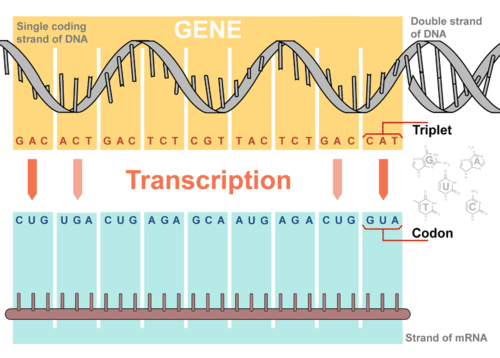
Transcription takes place in the nucleus. It uses DNA as a template to make an RNA (mRNA) molecule. During transcription, a strand of mRNA is made that is complementary to a strand of DNA. Figure 1 shows how this occurs.

Figure 1. Overview of Transcription. Transcription uses the sequence of bases in a strand of DNA to make a complementary strand of mRNA. Triplets are groups of three successive nucleotide bases in DNA. Codons are complementary groups of bases in mRNA.
You can also walk through the steps of transcription in this link.Transcription takes place in three steps: initiation, elongation, and termination. The steps are illustrated in Figure 2.

Figure 2. Transcription occurs in the three steps—initiation, elongation, and termination—all shown here.
Initiation is the beginning of transcription. It occurs when the enzyme RNA polymerase binds to a region of a gene called the promoter. This signals the DNA to unwind so the enzyme can ‘‘read’’ the bases in one of the DNA strands. The enzyme is now ready to make a strand of mRNA with a complementary sequence of bases.
Elongation is the addition of nucleotides to the mRNA strand. RNA polymerase reads the unwound DNA strand and builds the mRNA molecule, using complementary base pairs. There is a brief time during this process when the newly formed RNA is bound to the unwound DNA. During this process, an adenine (A) in the DNA binds to an uracil (U) in the RNA.
Termination is the ending of transcription, and occurs when RNA polymerase crosses a stop (termination) sequence in the gene. The mRNA strand is complete, and it detaches from DNA.
This video provides a review of these steps. You can stop watching the video at 5:35. (After this point, it discusses translation, which we’ll discuss in the next outcome.)